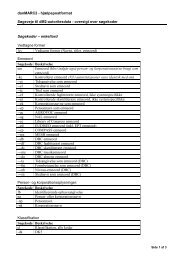RFID Data Model for Libraries - biblstandard
RFID Data Model for Libraries - biblstandard
RFID Data Model for Libraries - biblstandard
You also want an ePaper? Increase the reach of your titles
YUMPU automatically turns print PDFs into web optimized ePapers that Google loves.
<strong>RFID</strong> <strong>Data</strong> model <strong>for</strong> libraries Doc 067<br />
Any suggestions <strong>for</strong> the integration of these features in the mentioned protocols are outside<br />
the scope of the data model. Some may wish this to be an unsettled issue as it could be an area<br />
of competition among several suppliers. One way of dealing with the issue could be to make<br />
an application agent that would communicate with the <strong>RFID</strong> application and then<br />
communicated with the ILS <strong>for</strong> transactions covered by the mentioned protocols and also<br />
communicated with an application controlling the functionality not covered by the protocols<br />
and the ILS.<br />
The figure illustrates these considerations<br />
2.6.3 Application Family Identifier - AFI<br />
The ISO 15961-15963 standards specify the introduction of Application Family Identifier<br />
(AFI) <strong>for</strong> the purpose of identifying different application areas. This can be compared to the<br />
country code in an ISBN. The application specific AFI is a method also to avoid confusion if<br />
a person carries an item with an <strong>RFID</strong> tag from one application area into another application<br />
area. An example could be a library book brought into a supermarket. Under given conditions<br />
an <strong>RFID</strong> tag could be misinterpreted by another application area system.<br />
The AFI is specified in the systems part of a tag according to the generic standards in this<br />
field.<br />
Some security methods are also depending on the use of AFI or a pair of AFI’s. See section<br />
2.6.4.<br />
The working group can endorse the concept of AFI to identify the library area. The working<br />
group has been seeking ways of having a pair of AFI specified <strong>for</strong> library usage. It has,<br />
however, not been possible to find ways to do so. There is not obvious address to go <strong>for</strong> a pair<br />
of AFI’s. However, in the final editorial phase new in<strong>for</strong>mation has been tabled.<br />
The working group is concerned that this area is still unclear and might suggest that the<br />
existing standards are not yet sufficiently implemented to secure AFI as specified in the<br />
standards <strong>for</strong> an application area like libraries to have AFI allocated according to needs.<br />
21




